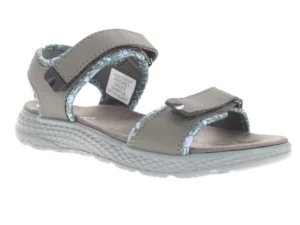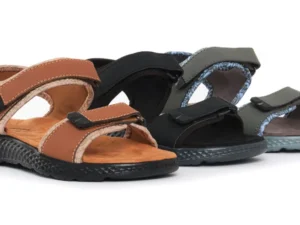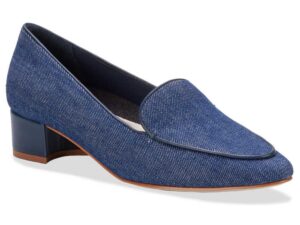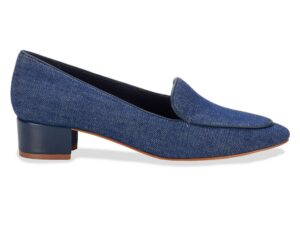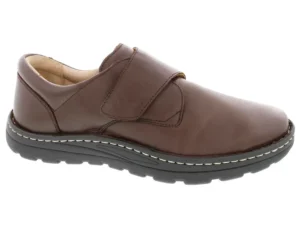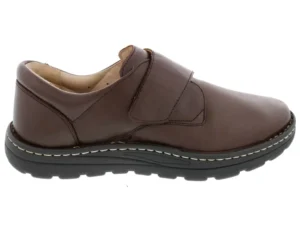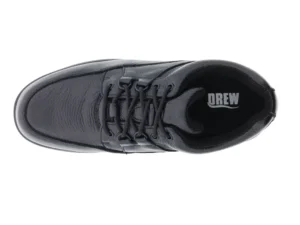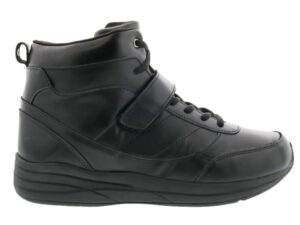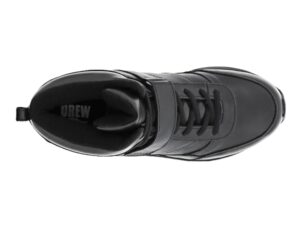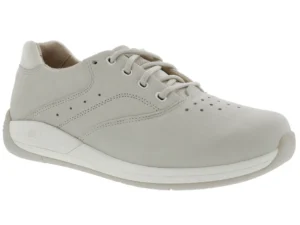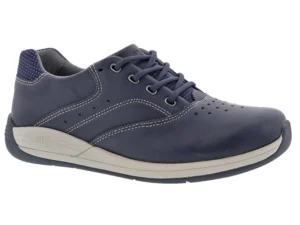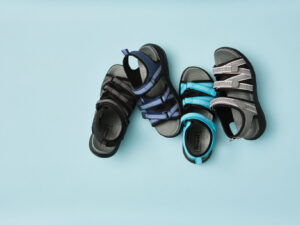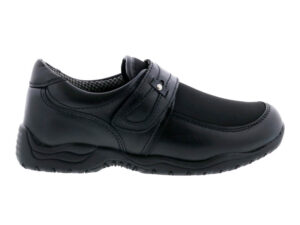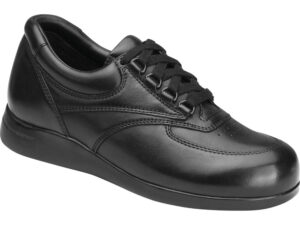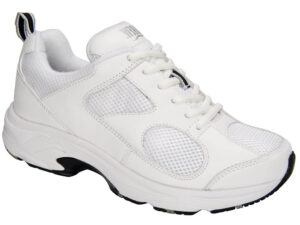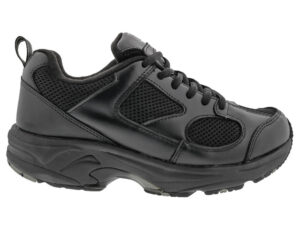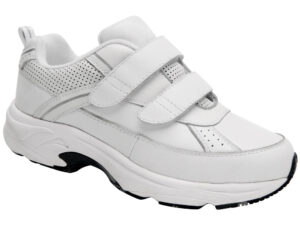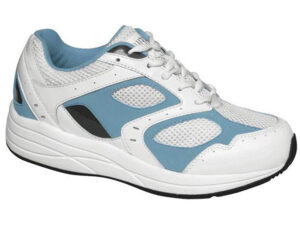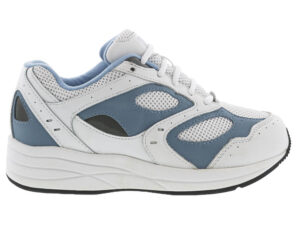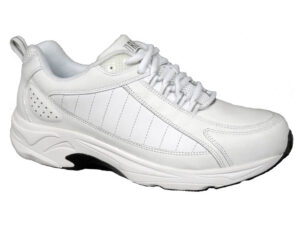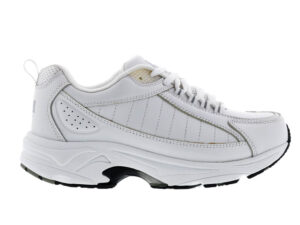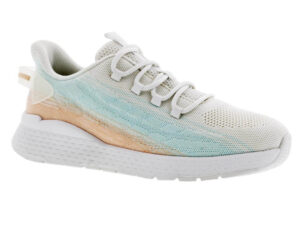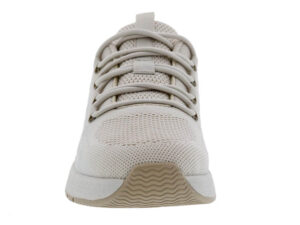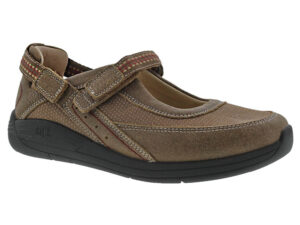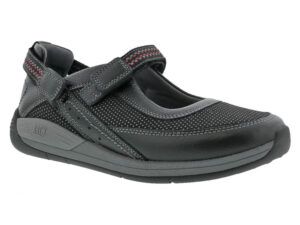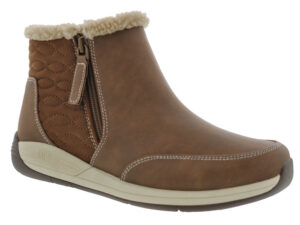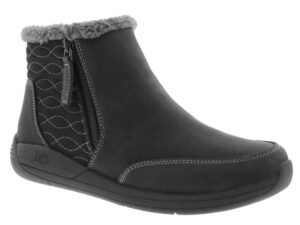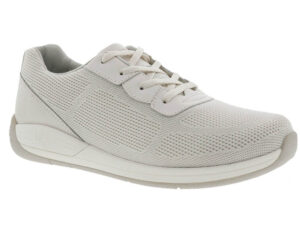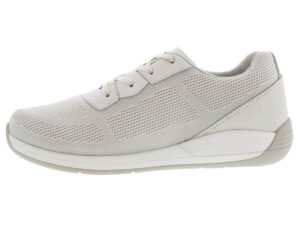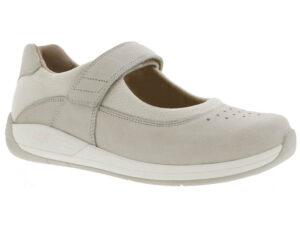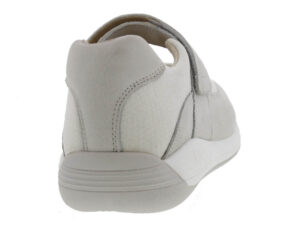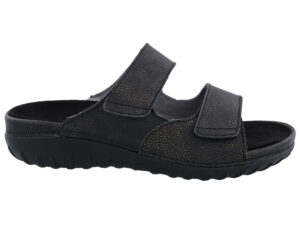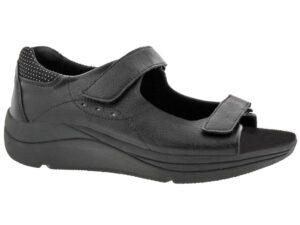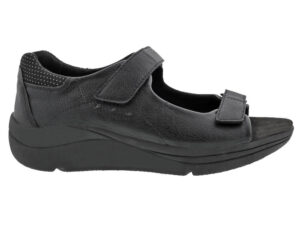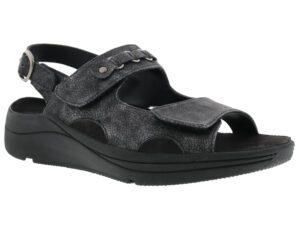Updated: 4/25/2024
What does a 4E shoe size mean?
The simple answer is that a 4E, or EEEE, shoe width is 4x wider than a “normal” width shoe.
In this article we’ll go deeper to provide a comprehensive answer to the most commonly asked questions how shoe widths are measured and the meaning and importance of 4E wide shoe widths.
What You’ll Learn
| Article Topic | Summary |
|---|---|
| Meaning of 4E in Shoes | 4E refers to the width of the shoe. It is considered an extra-wide width, providing extra space across the ball and toes of the foot. |
| Difference Between 4E and 2E | A 4E width is about 1/4 to 3/16 of an inch wider than a 2E width. The difference is more pronounced in larger shoe sizes. |
| 4E Shoes and Medical Conditions | 4E width shoes can benefit individuals with certain medical conditions that cause wider or swollen feet. However, they are also suitable for anyone who finds standard width shoes too narrow. |
| 4E Shoes and Comfort | 4E shoes can improve comfort by providing extra space for the foot to spread naturally, reducing pressure and improving balance. |
| Finding Stylish 4E Shoes | Many shoe brands offer stylish options in 4E widths. It’s crucial to consider both fit and style when choosing shoes. |
| Caring for 4E Shoes | Regular cleaning, proper drying, and correct storage can help extend the life of your 4E shoes. |
Quick Links
 What Is The Meaning of ‘4E’ In Shoe Sizes?
What Is The Meaning of ‘4E’ In Shoe Sizes?
The term ‘4E’ in shoes refers to the width size. When a shoe is labeled as 4E, it means the shoe is extra wide. It is important to note that the standard width for men’s shoes is ‘D’, and for women, it’s ‘B’. As the letters progress from A to E, the width of the shoe increases. A ‘4E’ shoe, therefore, is much wider than standard-width shoes and is designed to accommodate feet that require more room in the shoe.
In the shoe sizing system, there are typically four main width categories: Narrow, Standard, Wide, and Extra Wide. The ‘4E’ falls under the Extra Wide category. This means that these shoes are particularly beneficial for individuals with certain foot conditions such as flat feet, bunions, or edema, which require more space for comfort and healthy foot function.
Before delving into the specifics of 4E shoes, it’s important to understand the anatomy of a shoe. The key elements of a shoe include the upper part, the insole, the outsole, and the midsole. The width of a shoe is determined by the design of the upper part and the insole, with the 4E width referring to a larger than average space in these areas.
The shoe industry doesn’t have a universal standard for width measurements. This means that a 4E width in one brand may differ slightly from a 4E width in another brand. The size and width of a shoe can also be influenced by the specific style and model of the shoe.
When it comes to the specifics of the 4E width, the exact measurements can vary between men’s and women’s shoes, and among different shoe manufacturers. In general, a 4E width in men’s shoes corresponds to a width of around 4 1/2 inches to 6 inches at the ball of the foot. For women’s shoes, a 4E width usually measures around 3 1/2 inches to 5 inches across.

If you’re shopping for 4E width shoes, it’s crucial to try them on before making a purchase. Since width measurements can vary among brands, trying on shoes will give you a clear idea of the fit. Remember, a shoe should feel comfortable as soon as you put it on.
To find the perfect 4E shoes, consider seeking out brands that specialize in wide-width shoes. These brands design their shoes with wider foot shapes in mind and offer a range of widths to choose from. Some examples of 4E shoes include athletic shoes, casual shoes, and even dress shoes.
For athletic footwear, you might consider the Men’s Athletic Velcro Walking Shoes which provide a wide base for better stability and support. For everyday wear, the Men’s Fitec 9735-5L Walking Shoe offers a comfortable fit for wider feet. For more formal occasions, Dr. Comfort Men’s Dress Shoe Wing is a great choice that combines style and comfort.
Finally, it’s important to note that wearing shoes with the correct width is just as important as wearing the correct length. Shoes that are too narrow can cause foot problems such as bunions, hammertoes, and corns, while shoes that are too wide can lead to instability and lack of proper support.
How is 4E Different from 2E in Shoe Sizes?
While 4E and 2E are both indicative of wide shoe sizes, they are not the same. The primary difference between them lies in the degree of width they represent. The 2E width, also referred to as ‘wide’, is broader than the standard size but not as wide as a 4E.
Shoe widths can be considered on a spectrum, where B (for women) or D (for men) represents the medium or standard width. A 2E (or EE) width is one step wider than the standard width, providing extra room for the foot, while a 4E width is two steps wider than standard, offering even more space.
To put it in perspective, if you’re a man with a foot width of around 4 inches at the ball of the foot, a 2E width might be the right fit. However, if your foot measures closer to 5 inches in width, a 4E width would likely be more suitable. Keep in mind that these measurements are approximate, as shoe widths can vary between brands and styles.
While choosing between a 2E and a 4E, comfort should be your guiding principle. It’s crucial to try both widths to determine which feels more comfortable and provides the right amount of room for your feet.
The 2E Men’s Outdoor High Top Boot and the 4E Men’s Leather Composite Toe Work Boot are good examples of shoes in these two width categories. Both provide the extra space needed for wider feet, but the 4E Work Boot is designed to accommodate significantly wider feet than the 2E High Top Boot.
The number of brands offering wide and extra-wide shoes has been steadily increasing over the years. This is due to a greater recognition of the diversity of foot shapes and sizes, and the need to provide comfortable, well-fitting shoes for everyone.
Regardless of whether you choose a 2E or a 4E width, remember that the right fit should not squeeze your foot or leave too much room inside the shoe. A well-fitted shoe provides adequate space for your toes to wiggle, doesn’t slip off your heel, and doesn’t put pressure on any part of your foot.
“A shoe is not merely a fashion statement; it’s a testament to comfort and wellbeing. Understanding shoe widths like 4E and 2E is more than a sizing detail. It’s about acknowledging that every foot is unique, and deserves the perfect fit. The right width in a shoe can transform a long walk into a stroll and a day at work into a comfort experience. After all, life is too short for ill-fitting shoes.”
How Do I Know If I Need 4E Width Shoes?
Identifying whether you need a 4E width shoe involves measuring your foot’s width and understanding how your current shoes fit or feel. Here are some signs that might suggest you need a 4E width shoe.
If your current shoes feel tight around the sides of your foot, particularly around the ball of your foot (the widest part), it’s likely that you need a wider shoe size. If you see visible stretching or bulging on the sides of your shoes, that’s another sign that your shoes are too narrow.
Another indicator is frequent foot problems such as blisters, bunions, or corns, which can often be attributed to wearing shoes that are too narrow. If your toes are crowded and unable to move freely, or if your shoes leave indentations on your feet, these are also signs that you need a wider shoe.
To accurately determine whether you need a 4E width, you can measure your foot’s width. You’ll need to place your foot on a piece of paper, draw around it, and then measure the width at the widest part (usually the ball of your foot). You can then compare this measurement with the shoe manufacturer’s sizing chart to determine if a 4E width is right for you.
Professional shoe fitting is another option. Many shoe stores and foot health professionals offer this service. They can accurately measure your foot’s length and width and can provide advice on the best shoe sizes and styles for your foot type.
Remember that a comfortable fit is crucial. If your shoes feel too tight, cause pain or discomfort, or lead to foot problems, it may be time to consider a wider shoe size. Opting for a 4E shoe can provide the additional room your feet need, enhancing comfort and promoting better foot health.
When choosing 4E shoes, remember to consider the shoe’s overall shape and construction. The shoe should have a wide toe box that doesn’t squeeze your toes together, a supportive arch, and a snug heel that doesn’t slip when you walk.
Shopping for wider shoes can sometimes be a challenge, as not all shoe stores carry a wide selection of wide-width shoes. However, with the increasing recognition of the need for varied shoe sizes, more and more brands are offering wider options. You can also find a good selection of wide-width shoes online, such as the 4E Men’s Leather Composite Toe Work Boot.
How to Measure Foot Width for 4E Shoes?
Proper measurement of your foot width is crucial to determining whether you need a 4E shoe. Here’s a step-by-step guide to help you measure your foot width accurately.
- Gather your materials: You’ll need a piece of paper larger than your foot, a pencil, a ruler, and socks that are typical of what you’d wear with your shoes.
- Step on the paper: Place your foot on the paper. Be sure to stand and distribute your weight evenly to get the most accurate measurement.
- Outline your foot: Trace around your foot as closely as possible. It’s best to use a pencil for this, as it can get as close to your foot as possible.
- Draw straight lines: Draw a straight line at the top of your longest toe and at the back of your heel. Then, draw another straight line at the widest part of your foot, which is usually across the ball of your foot.
- Measure: Use your ruler to measure the distance between the two lines at the widest part of your foot. This is your foot width.
- Compare: Compare this measurement to the shoe size chart provided by the shoe manufacturer.

These measurements can then be compared with the shoe manufacturer’s sizing guide to determine your shoe width. Keep in mind that shoe sizes and widths can vary between brands, so it’s always a good idea to check each brand’s specific sizing chart. You might also find that your foot size changes over time, so regular measurements can ensure that you always have the best fit.
If you’re shopping online for 4E shoes, using these measurements can be particularly useful. Online shoe retailers often provide detailed sizing guides that can help you choose the right shoe width based on your measurements. For example, if you’re shopping for the 4E Men’s Athletic Velcro Walking Shoes, you can compare your foot measurements with the brand’s sizing guide to determine the best fit.
Can I Wear 4E Shoes If I Don’t Need Extra Wide Shoes?
Technically, you can wear 4E shoes even if you don’t need extra wide shoes, but it might not be the best idea. Wearing shoes that are too wide for your feet can lead to issues such as blisters, since your foot may slide around inside the shoe. It can also lead to foot fatigue and instability as your foot is not properly supported.
The best fitting shoe not only matches the length of your foot but also its width. When your shoes fit well, they align with the natural shape of your feet. They provide room for your toes to move, support for your arches, and a secure fit around your heels.
Wearing shoes that are too wide can also alter your natural gait, as you may subconsciously adjust your walking pattern to prevent the shoes from slipping off. This can lead to muscle imbalances, foot pain, and even issues in other parts of your body such as your knees and back.
If you feel that your current shoes are too tight, but aren’t sure if you need a 4E width, you might consider trying a slightly wider width first, such as 2E. Trying on different shoe widths can help you find the perfect fit.
Remember that the right shoe should feel comfortable from the moment you put it on. It should not require a “break-in” period. If you have any discomfort or pain, it’s a sign that the shoes may not be the right width or size for you.
In conclusion, while you can wear 4E shoes if you don’t need extra wide shoes, it’s not generally recommended due to the potential for discomfort and foot health issues. It’s always best to wear shoes that properly fit the length and width of your feet for optimal comfort and support.
How to Stretch Shoes to 4E Width?
If you have a pair of shoes that you love but they’re too narrow for your feet, you might wonder if you can stretch them to a 4E width. While it’s possible to stretch shoes to some extent, there are limits to how much a shoe can be stretched without damaging it.
Most shoes can be stretched slightly in width to accommodate slightly wider feet. However, attempting to stretch a standard width shoe to a 4E width is likely to cause damage to the shoe and won’t provide the comfort and fit that a true 4E width shoe would.
There are shoe stretching devices available that can help to expand the width of a shoe. These devices, known as shoe stretchers, are inserted into the shoe and then expanded to stretch the shoe material. This can create a bit more room in the width of the shoe.
If you choose to use a shoe stretcher, it’s important to use it correctly to avoid damaging the shoe. Always follow the instructions provided with the stretcher, and avoid overstretching the shoe. Keep in mind that different materials will respond differently to stretching, and some materials may not stretch at all.
Shoe stretching sprays can also be used in combination with a shoe stretcher for better results. These sprays help to soften the shoe material, making it easier to stretch.
While stretching can provide a bit more room in a shoe, it’s not a solution for shoes that are significantly too narrow. A shoe that is stretched too much can become damaged and lose its shape. Overstretching can also affect the support and structure of the shoe, potentially making it less comfortable or less effective in supporting your foot.
Instead of trying to stretch a standard width shoe to a 4E width, it’s recommended to invest in a shoe that is designed with a 4E width. This will ensure that the shoe provides the room, comfort, and support that your feet need. Brands like Dr. Comfort offer a range of stylish and comfortable shoes designed for wider feet.
How Much Bigger Is 4E than 2E in Shoes?
When it comes to shoe widths, 4E and 2E represent different measurements. Typically, a 4E width is approximately 1/4 to 3/16 of an inch wider than a 2E width in the same shoe size. However, the actual difference can vary between different shoe manufacturers and styles.
Despite this small measurement difference, the change in comfort can be noticeable for individuals with wider feet. A 4E width shoe provides additional room across the ball of the foot and toes, which can be a relief for those who find that 2E width shoes are slightly too narrow.
It’s also worth noting that as the shoe size gets larger, the difference between a 2E and 4E width also becomes more pronounced. This is because shoe widths are proportional to shoe lengths. So, a size 10 4E width shoe will be wider than a size 8 4E width shoe.
For those who need a wider shoe but find the jump from 2E to 4E to be too much, some manufacturers also offer intermediate widths, such as 3E. However, these can be more difficult to find.
Finding the perfect shoe width can take some trial and error. Trying on different widths can be helpful in determining what feels the most comfortable and provides the best fit.
Are 4E Shoes Only for People with Medical Conditions?
4E width shoes are not exclusively for individuals with medical conditions. Anyone who finds that standard width shoes are too narrow for their feet may benefit from wearing a 4E width shoe. That being said, individuals with certain foot conditions or deformities may find 4E width shoes to be particularly beneficial.
Certain medical conditions can cause the feet to become wider, swollen, or require extra room for orthotic devices. Conditions like edema, bunions, hammertoes, and certain types of arthritis can alter the shape and size of the feet, often requiring extra wide shoes for comfort and accommodation.
Additionally, some individuals may simply have naturally wider feet. Wearing shoes that are too narrow can lead to discomfort, foot pain, and various foot problems. In these cases, a 4E width shoe can provide the additional room needed for comfort and proper foot health.
But even if you don’t have a specific medical condition, if you find that standard width shoes are too tight or uncomfortable, it may be worth considering a wider shoe width like 4E. Comfort should always be a key consideration when choosing shoes.
Can 4E Shoes Improve Comfort?
Yes, 4E shoes can greatly improve comfort, particularly for individuals with wider feet. Shoes that are too narrow can squeeze the foot, causing discomfort and a range of foot problems such as blisters, corns, and calluses.
4E width shoes offer extra room across the width of the shoe, providing more space for the foot to spread naturally. This additional space can reduce pressure on the foot, improve balance, and allow for better foot movement.
The benefits of 4E shoes are not just physical. Wearing comfortable, well-fitting shoes can also improve your overall wellbeing. When your shoes are comfortable, you’re likely to be more active and spend more time on your feet, which can have positive effects on your overall health.
It’s important to remember, however, that a wider shoe is not the solution for everyone. The ideal shoe provides a balance of length, width, and depth to suit your specific foot shape and size. A shoe that is too wide can be just as problematic as a shoe that is too narrow. If you’re unsure about your shoe size or width, it can be beneficial to have your feet professionally measured.
How Can I Find Stylish 4E Shoes?
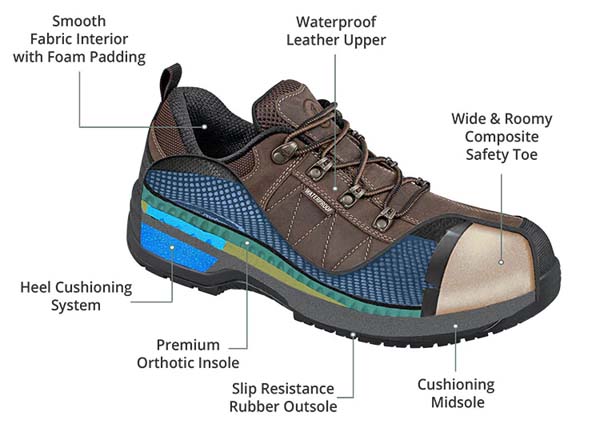
One common misconception is that extra wide shoes are not as stylish as standard width shoes. However, this is not the case. Many shoe brands understand the need for wide-width shoes and offer a range of stylish options in 4E widths.
When shopping for stylish 4E shoes, it’s crucial to consider the shoe’s overall fit and comfort, as well as its appearance. A shoe that looks good but is uncomfortable or ill-fitting can cause foot problems and won’t be a good addition to your wardrobe.
You can find stylish 4E shoes in various types, from casual sneakers to formal dress shoes. Brands such as Apis offer fashionable walking shoes in 4E widths that are ideal for everyday wear. For more formal occasions, Orthofeet offers work shoes in 4E widths that combine style and comfort.
Online shopping can also be a great way to find stylish 4E shoes. Many online retailers offer a wider selection of sizes and styles than traditional brick-and-mortar stores. When shopping online, be sure to check the retailer’s sizing guide and return policy, as shoe sizes can vary between brands.
Remember, the key to finding stylish 4E shoes is to not compromise on comfort. The most fashionable shoe in the world won’t be worth much if it’s uncomfortable to wear. Always prioritize fit and comfort when shopping for new shoes.
How Can I Care for My 4E Shoes?
Caring for your 4E shoes is similar to caring for any other shoes. Regular cleaning and proper storage can help extend the life of your shoes and keep them looking their best.
For most shoes, regular cleaning involves removing dirt and dust with a soft cloth or brush. For leather shoes, you might also use a specialized leather cleaner or conditioner. Always follow the manufacturer’s cleaning instructions to avoid damaging the shoes.
Allowing your shoes to dry properly after wearing can also help prolong their life. If your shoes get wet, stuff them with newspaper or use a shoe dryer to absorb the moisture. Avoid placing them near a heat source, as this can cause the shoes to dry out and crack.
Rotating your shoes can also help them last longer. Wearing the same shoes every day can cause them to wear out quickly. By rotating between a few pairs, you can give each pair a chance to rest and recover between wears.
Proper storage is also important. Store your shoes in a cool, dry place away from direct sunlight. Use a shoe rack or shoe tree to help maintain their shape.
Finally, consider using a waterproofing spray for shoes that are frequently exposed to wet conditions. This can help protect the shoes from water damage and extend their life.
With proper care and maintenance, your 4E shoes can remain comfortable and stylish for a long time. Whether you choose a casual pair of Outdoor High Top Boots or a more formal Leather Composite Toe Work Boot, taking the time to care for your shoes is well worth the effort.
Conclusion
The world of shoe sizing extends beyond the basic numbers and encompasses a diverse range of widths, such as 4E and 2E. These wider options cater to the unique foot shapes and sizes of individuals, providing comfort and ease in movement. Not merely for those with medical conditions, 4E width shoes can offer unparalleled comfort to anyone seeking extra room. Whether it’s finding a stylish pair of shoes, understanding the difference between widths, or learning how to care for your footwear, knowledge is key. The right fit in shoes not only improves daily activities but also boosts self-confidence and well-being. It’s time to step into the comfort zone and embrace the fit that’s right for you.

 What Is The Meaning of ‘4E’ In Shoe Sizes?
What Is The Meaning of ‘4E’ In Shoe Sizes?